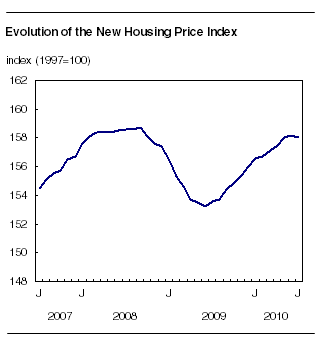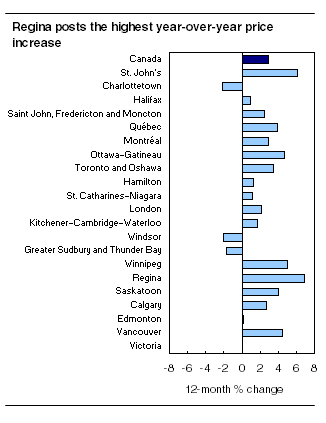Common menu bar links
New Housing Price Index
Archived Content
Information identified as archived is provided for reference, research or recordkeeping purposes. It is not subject to the Government of Canada Web Standards and has not been altered or updated since it was archived. Please "contact us" to request a format other than those available.
Related subjects
The New Housing Price Index (NHPI) decreased 0.1% in July following a 0.1% increase in June. This was the first decrease at the Canada level in 13 months.
The top contributors to the NHPI monthly decrease were Vancouver, London and Greater Sudbury and Thunder Bay.

Between June and July, prices decreased the most in Greater Sudbury and Thunder Bay (-1.9%), London (-1.8%) and Windsor (-1.5%). In these cities, as well as in Hamilton and St. Catharines–Niagara, prices decreased partly as a result of the introduction of the Harmonized Sales Tax, which is excluded from the calculation of the NHPI.
In July, prices increased in 3 of the 21 metropolitan areas. The largest increase recorded was in Kitchener–Cambridge–Waterloo (+0.6%), where builders increased their prices as a result of competitive market conditions.
Year over year, the NHPI was up 2.9% in July following a 3.3% increase in June.
The main contributors to the year-over-year increase were Toronto and Oshawa as well as Vancouver.

The largest year-over-year increase was recorded in Regina (+6.9%), followed by St. John's (+6.1%) and Winnipeg (+5.0%).
Compared with July 2009, contractors' selling prices were also higher in Ottawa–Gatineau (+4.7%), Vancouver (+4.5%) and Saskatoon (+4.0%).
Among the 21 metropolitan areas surveyed, 3 registered 12-month declines in July: Charlottetown (-2.1%), Windsor (-2.0%) and Greater Sudbury and Thunder Bay (-1.7%).
Note: The New Housing Price Index (NHPI) measures changes over time in the selling prices of new residential houses agreed upon between the contractor and the buyer at the time of the signing of the contract. It is designed to measure the changes in the selling prices of new houses where detailed specifications pertaining to each house remain the same between two consecutive periods. The prices collected from builders and included in the index are market selling prices less value added taxes, such as the Federal Goods and Services Tax (GST) or the Harmonized Sales Tax (HST).
The HST came into effect July 1st, 2010, in Ontario and British Columbia. Prior to the introduction of the HST, the provincial sales tax on building materials in Ontario and in British Columbia was embedded in the contractors' selling prices of new houses. With the introduction of the HST in these two provinces, the provincial sales tax was replaced by the HST. As value added taxes are conceptually excluded from the index, this change may cause negative monthly variations in the index for some metropolitan regions in Ontario and British Columbia during the implementation period of the tax.
This release presents data that are not seasonally adjusted, and the indexes published are final.
Available on CANSIM: table 327-0005.
Definitions, data sources and methods: survey number 2310.
The second quarter 2010 issue of Capital Expenditure Price Statistics (62-007-X, free) will be available in October.
The New Housing Price Index for August will be released on October 13.
For more information, or to enquire about the concepts, methods or data quality of this release, contact Client Services (toll-free 1-888-951-4550; 613-951-4550; fax: 613-951-3117; ppd-info-dpp@statcan.gc.ca), Producer Prices Division.
Table 1
| 2010 | July 2009 | June 2010 | July 2010 | June to July 2010 | July 2009 to July 2010 | |
|---|---|---|---|---|---|---|
| relative importance1 | (1997=100) | % change | ||||
| Canada total | 100.00 | 153.6 | 158.2 | 158.0 | -0.1 | 2.9 |
| House only | ... | 161.1 | 168.5 | 168.4 | -0.1 | 4.5 |
| Land only | ... | 137.9 | 137.7 | 137.4 | -0.2 | -0.4 |
| St. John's | 1.20 | 181.1 | 192.1 | 192.1 | 0.0 | 6.1 |
| Charlottetown | 0.31 | 121.0 | 118.8 | 118.5 | -0.3 | -2.1 |
| Halifax | 1.22 | 150.5 | 151.8 | 151.8 | 0.0 | 0.9 |
| Saint John, Fredericton and Moncton2 | 0.88 | 120.4 | 123.4 | 123.4 | 0.0 | 2.5 |
| Québec | 2.46 | 165.5 | 171.9 | 171.9 | 0.0 | 3.9 |
| Montréal | 10.11 | 165.3 | 170.1 | 170.1 | 0.0 | 2.9 |
| Ottawa–Gatineau | 4.71 | 169.7 | 177.6 | 177.6 | 0.0 | 4.7 |
| Toronto and Oshawa2 | 33.99 | 144.7 | 149.7 | 149.7 | 0.0 | 3.5 |
| Hamilton | 2.96 | 150.9 | 153.2 | 152.8 | -0.3 | 1.3 |
| St. Catharines–Niagara | 0.96 | 154.9 | 157.0 | 156.8 | -0.1 | 1.2 |
| London | 1.91 | 144.4 | 150.3 | 147.6 | -1.8 | 2.2 |
| Kitchener–Cambridge–Waterloo | 2.17 | 142.7 | 144.3 | 145.1 | 0.6 | 1.7 |
| Windsor | 0.65 | 104.2 | 103.7 | 102.1 | -1.5 | -2.0 |
| Greater Sudbury and Thunder Bay2 | 0.85 | 112.7 | 113.0 | 110.8 | -1.9 | -1.7 |
| Winnipeg | 1.62 | 182.9 | 191.6 | 192.1 | 0.3 | 5.0 |
| Regina | 0.59 | 250.9 | 268.3 | 268.3 | 0.0 | 6.9 |
| Saskatoon | 0.81 | 211.4 | 219.8 | 219.8 | 0.0 | 4.0 |
| Calgary | 7.88 | 230.0 | 236.3 | 236.3 | 0.0 | 2.7 |
| Edmonton | 8.29 | 208.3 | 208.7 | 208.7 | 0.0 | 0.2 |
| Vancouver | 14.39 | 114.3 | 120.4 | 119.4 | -0.8 | 4.5 |
| Victoria | 2.04 | 106.1 | 106.0 | 106.1 | 0.1 | 0.0 |

